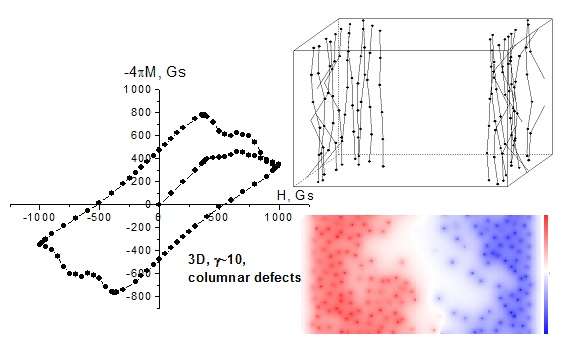Scientists remagnetize layered high-temperature superconductors

Hard superconductors are perspective materials for different applications, in particular, for getting strong (> 10 Tesla) magnetic fields. In such connections the destructions of superconductivity by the self-field of transport current happens because of overlap of normal cores of Abrikosov vortices and occur in a significantly larger magnetic field than in soft superconductors (which includes the majority of metals).
The creation of superconducting cables and tapes (used in magnet winding) requires connections, transferring to superconducting state in the highest possible temperature and having good transportation characteristics, such as the critical current density. For this purpose currently most widely layered high-temperature superconductors are used: Bi2Sr2CaCu2Ox (Bi-2212); Bi2Sr2Cа2Cu3Ox (Bi-2223) and YBa2Cu3O7 (Y-123). Such compounds have anisotropy, explained by crystal structure; Cu-O planes, divided by intercalate layers, are responsible for superconductivity. The value of the anisotropy parameter is a superconductor property and is famous for the majority of compounds, applied in practice. In these planes Abrikosov vortex lattice is formed, which are responsible for magnetic and transport properties of a sample. Compound's anisotropy characterizes the value of Josephson coupling, which appears between layering vortexes (so-called pancakes) in neighboring planes and, hence, the hardness of the vortex trunk and its ability to fix at different kinds of faults (pinning). When the current goes through a sample, which is in a mixed state, powers of interaction between current and magnetic field appear, the current spreading will change, and vortexes will start moving. But the movement of a normal vortex heart is accompanied by heat emission, and, hence, resistance appears. The current, at which the vortex movement starts, is called critical. For raising of the critical current on practice optimized defect structure, which guarantees the most effective pinning, needs to be created, that is why the analysis of behavior of the vortex lattice and possibility to predict magnetic and transportation properties of a sample depending on different factors, such as temperature, anisotropy, and faults of different nature, get the crucial importance.
Scientific group from the National Research Nuclear University MEPhI (Russia) under the supervision Professor V.A.Kashurnikov (Department of physics of solid body and nanosystems) has created and realized an algorithm on the basis of Monte Carlo method, which allows reproduce remagnetisation and evaluate transportation characteristics of layered anisotropy superconductor, considering the influence of interplane connection.
"The peculiarity of the algorithm is the possibility to consider vortex interaction with Meissner current, work with a variable number of vortexes, accepting production and destruction of vortexes near the border of the superconductor". Moreover, appearing of incomplete vortex trunk is accepted near the border. Hence, it becomes possible without artificial assumptions model penetration of a magnetic flow from border and analyse the influence of different factors at the process," said V.A.Kashurnikov.
The results of calculations qualitatively agree with calculations of other scientific groups and famous experimental data. The algorithm allows consecutively introduce into calculations different factors, able to influence critical current, and research the influence of each factor in a wide range of characterizing parametres. The calculations can be used to interpret experimental data, evaluate transportation properties of high temperature super conductivity bands with a defined type of pinning centres and in planning of new experiments.
More information:
AVBalakireva@mephi.ru
Provided by National Research Nuclear University